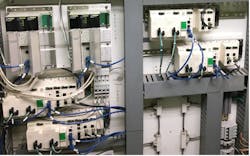When organizations continue to run mature or obsolete supervisory control and data acquisition (SCADA) systems and programmable logic controllers (PLCs), there are several business risks they could be facing, including increased and/or extended downtime and a variety of cybersecurity vulnerabilities. However, the possibility of requiring downtime to execute a modernization, along with other perceived risks of moving to an updated system—such as compatibility issues—prevent many companies from executing a much-needed modernization.
Following are three recommended steps to minimize the impact and risks of a needed automation update:
Execute in well-planned phases.We’ve seen many organizations shy away from modernization because they envision the project being performed as a rip and replace that requires a complete shutdown for many days or weeks. But at George T. Hall (GTH), we understand an extensive shutdown is not an option for most facilities, as lost production can be quite costly. Instead, we believe a well-planned, phased approach to modernization is more practical.
Select an integrator with proven modernization experience.While many integrators have experience performing SCADA and PLC modernizations, not many have been around long enough to have extensive experience working with legacy and modern systems. At GTH, we have many decades of experience serving as a platform-agnostic integrator and we are well-versed in working with a wide variety of software and hardware for SCADA systems.
We also have developed proven methods and systems to help us further minimize downtime and risk during modernization implementations. For example, as described above, a standard part of our modernization process is the extensive factory acceptance testing (FAT) we perform on our solutions. We also supplement this testing with extremely thorough documentation for all our systems. Additionally, we have several industry certifications and partnerships that provide our customers with early access to innovative technologies as well as higher levels of support. In this example above, our status as a Certified Automation Partner with Schneider Electric gave us access to UMAC, which made it much easier and faster to convert from the existing PLCs to the modern PACs.
Download our white paper to learn more about mitigating control system risks and inefficiencies with a well-planned phased SCADA modernization:
Michael Howard is vice president of system integration at George T. Hall Company, a certified member of the Control System Integrators Association (CSIA). For more information about George T. Hall Company, visit its profile on the CSIA Industrial Automation Exchange.



